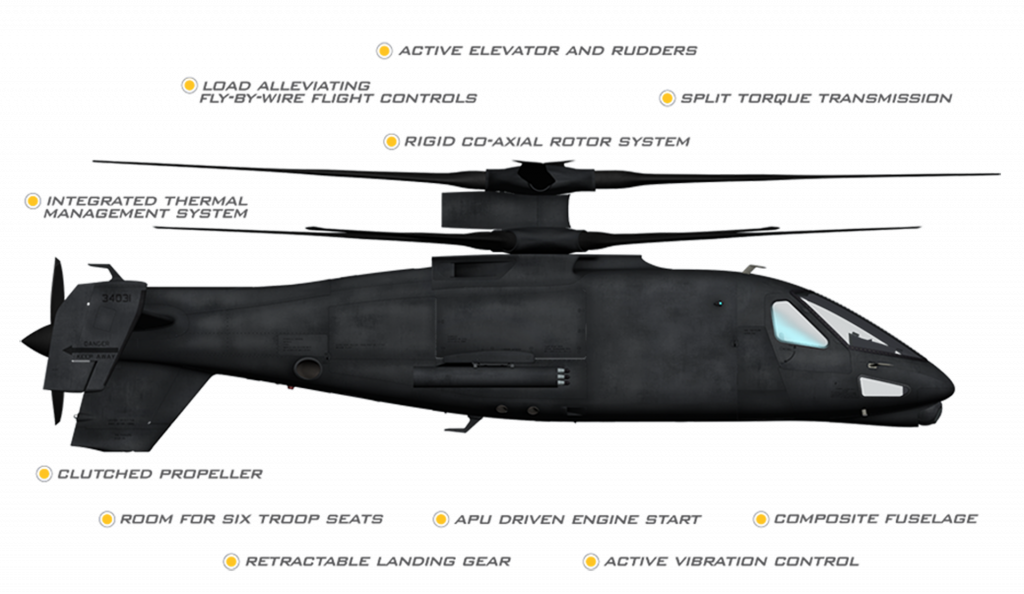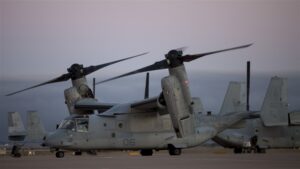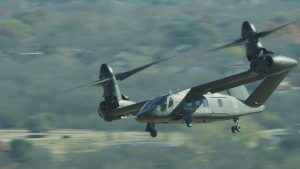SB>1 Revs Up In Ground Test: Expert Expects First Flight ‘In Weeks’
Posted on
WASHINGTON: Sikorsky and Boeing released video yesterday of their SB>1 Defiant helicopter in its first ground test, revving the revolutionary ultra-rigid rotor blades whose manufacturing troubles had cost the program months. But when will Defiant first take flight? While the companies declined to provide details, a leading rotary-wing expert predicted first flight “in the next few weeks.”
Meanwhile, archrival Bell has had its contender for the Army-led Future Vertical Lift program, the V-280 Valor tiltrotor, in test flights for over a year. Valor’s first ground test of its rotors at full power was in fall 2017. The comparable Defiant tests in the video were three weeks ago, on Jan. 8-9. (Leaked video surfaced a few days later – see below).
“Glad to see them actually turn the rotors. It’s one step in direction of actually flying,” one retired Army aviator told me. “They’re obviously seriously behind Bell’s V-280 that just this week pushed its forward speed to 296 knots.”
296 knots is 340 miles per hour. That’s more than 50 percent higher than the all-needles-in-the-red “Never Exceed Speed” on the UH-60 Black Hawks that FVL will replace. When I asked, Bell wouldn’t confirm or deny that they’d reached 296 knots, but they have confirmed 280, the intended cruise speed for which the V-280 is named.
Meanwhile the maximum speed that Defiant’s reached is, well, zero. But that should change quickly, and the delay should not be disqualifying, said Mike Hirschberg, executive director of the Vertical Flight Society.
“The Sikorsky-Boeing Defiant team has overcome a number of technical obstacles that weren’t inherently connected with their coaxial rotor system approach but delayed the assembly of the demonstrator,” Hirschberg told me.
What’s the issue? Bell’s Valor uses the same combat-proven tiltrotor technology as its widely employed V-22 Opsrey, which basically transforms from a helicopter to a turboprop airplane and back. The Defiant, by contrast, looks like a conventional coaxial helicopter (i.e. one set of blades on top of the other) with an additional pusher propeller on the back (making it a “compound helicopter”). When the pusher takes over, the main rotors effectively act as wings.
That requires rotors that. are much more rigid than those on a conventional helicopter. While Sikorsky’s smaller X2 and S-97 Raider prototypes have flown with such ultra-rigid blades, scaling them up for the larger Defiant proved unexpectedly difficult – especially since the Army asked the companies to try out new manufacturing techniques.
Sikorsky and Boeing say they worked out the bugs and have already run extensive, full power ground-tests with their Powertrain System Test Bed (PSTB), which is a mostly-complete Defiant bolted to the ground. But this is the first time they’ve put all the pieces together in a flyable aircraft and show it works.
“Now that they’ve completed the initial ground run, the team can finish its work to clear the aircraft for first flight,” Hirschberg said. And they have a chance to make up a little time, he added.
“It took more than three months of ground testing for the V-280 to make its first flight, but Bell also had to conduct rotor tilt testing”—a feature Defiant doesn’t have or need. “Assuming the Defiant team doesn’t find anything noteworthy from its ground testing,” he told me, “it should be up in the air in the next few weeks.”
Once in flight tests, Defiant will have a lot of catching up to do – but the Valor faces obstacles of its own. Unlike the Marines, Air Force, and Navy, the Army never bought the V-22 Osprey, so it’s not familiar with tiltrotors, while the Defiant design is a helicopter, with which the Army is very familiar. In particular, many aviators worry that tiltrotor designs — which require two rotors set far apart on opposite sides of the aircraft — are inherently more ungainly than helicopters in the low-speed, low-altitude maneuvers required to land troops or pick up casualties from forests, mountainsides, or cities. Bell, of course, denies this and is running tests and demo flights to prove Valor’s agility to the Army.
(If you talk with Marines, who’ve been operating V-22 tilt rotors for more than a decade, both pilots and troops extol its speed, capacity, range and ability to sweep into remote and difficult landing zones.)
Nevertheless, even before the Army announced it wanted a small and agile scout, the Future Attack Reconnaissance Aircraft, alongside the full-size FVL – now designated Future Long-Range Assault Aircraft – we’ve been hearing speculation that the service would split the buy. Sikorsky’s compound helicopter would get the scout mission because of its low-speed agility; Bell’s tiltrotor would get the assault mission because of its long-range fuel efficiency.
“My personal view is that this counter-rotating technology combined with a pusher prop is an attractive approach for FARA, but it doesn’t seem to scale well for a medium lift assault aircraft” like FLRAA, the retired aviator told me just yesterday.
So Defiant has to prove its efficiency, while Valor has to prove its agility. And with the Army not making its decision until 2021, this race is far from over.
Subscribe to our newsletter
Promotions, new products and sales. Directly to your inbox.



